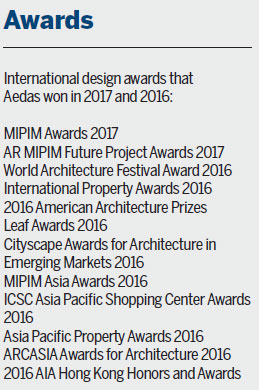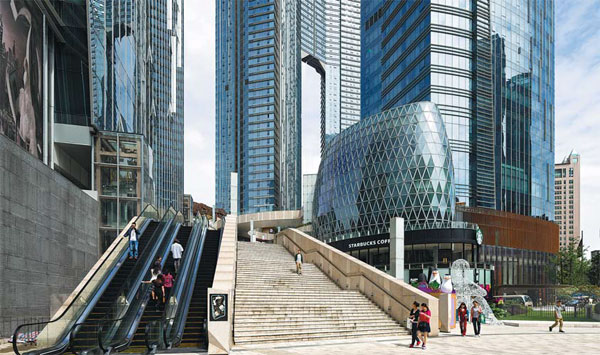Aedas set to expand China offices to join urbanization boom
Aedas, one of the world's leading architectural design companies, had accumulated extensive experience working in cities along the Belt and Road routes before China proposed the initiative in 2013.
The company encountered a great opportunity when it was established decades ago, witnessing a resurgence of the ancient Maritime Silk Road centered around development, railways and airports.
The revitalization encouraged developers from Hong Kong to engage in Southeast Asian projects, and in turn Malaysian, Singaporean and Indonesian developers came to work in Hong Kong and the Chinese mainland.
|
One of Aedas' design masterpieces is the Evergrande Huazhi Plaza in Chengdu. Photos Provided to China Daily |
|
Keith Griffiths, chairman and founder of Aedas, explains his ideas at TEDxFuxing Park. |
"When Aedas established its business in Hong Kong in 1985, we followed the developers and the Mass Transit Railway as they ventured out from Hong Kong," said Keith Griffiths, chairman and founder of the company, from the United Kingdom.
This move helped Aedas to grow from its humble beginnings as a two-person design house into an international firm by 1997. It now has offices along the ancient sea route from Shanghai, Hong Kong and Singapore, to Dubai and Abu Dhabi in the Middle East, and London in western Europe. It boasts more than 1,400 staff working in 12 offices worldwide.
This year, the company plans to open a new office in Shenzhen, Guangdong province. It will also establish a strong network by integrating the office with its existing four China bases in the next five years, to form a backbone in the region.
"China is entering a period of more considered and sophisticated planning and construction. I anticipate that Aedas will employ more Chinese mainland designers and our China offices will grow substantially," Griffiths said.
In addition to focusing on its traditional business sectors, Aedas is expanding into new building types in the country, such as technology hubs, healthcare and educational and cultural facilities.
The company also undertook urban renewal and restoration projects recently, as China is redeveloping old urban areas to upgrade facilities and improve existing infrastructure.
Using old and new infrastructure efficiently, Griffiths said that urban renewal can make cities become more compact and preserve valuable agricultural land. It can provide a strong live-work-recreate environment, conserve energy and reduce pollution and travel distances, he added.
China has urbanized about 500 million people in the past two decades through its high-density city planning and the fast pace of its subway and rail systems' development.
"In the course of this urbanization, China is the only country to develop successful live-work, high-density urban habitats," Griffiths said.

The National Plan on New Urbanization, designed for the 2014-20 period, has introduced a series of key measures to improve the process and product of urbanization, in a bid to help create sophisticated and livable cities that are well coordinated with infrastructure networks and utilize land efficiently.
"We will be increasing our presence and work along the Belt and Road, and also will become deeply involved in forming the new sustainable cities of China in response to China's new urban planning strategy for creating world models of efficient, sustainable and vibrant cities with our highly-specialized knowledge and experience," Griffiths said. One goal of the Belt and Road Initiative is to facilitate closer economic cooperation in the region and beyond through infrastructure development. That will offer many city-based design opportunities for architects along the routes. "It will be important for Chinese architects to travel and understand the countries - their cultures, regulations and peoples," Griffiths said.
Localization is an important value that Aedas has emphasized for years. The company believes that world-class design solutions require designers to understand and respect the social and cultural needs of the local community for whom they are designing.
The company features more than 100 projects on its website, which locate in cities such as Beijing, Sanya, Jeddah, London and Dubai.
The ongoing China World Trade Center Phase 3C project, for example, is located in Beijing. It will be the fifth and final phase of the trade center, a top commercial multipurpose development in the country.
The project, directed by the company's Global Board Director Andrew Bromberg, will be designed to serve as a focal point or a front door of the complex, in a bid to become a catalyst as a cultural center that brings people together. In March, the project achieved a double win at the international event MIPIM, the world's largest property fair, in France.
It won Best Future Project at the MIPIM Awards 2017 and a merit award in the retail and leisure category at the Architectural Review MIPIM Future Project Awards.
haonan@chinadaily.com.cn
(China Daily 05/14/2017 page39)
















